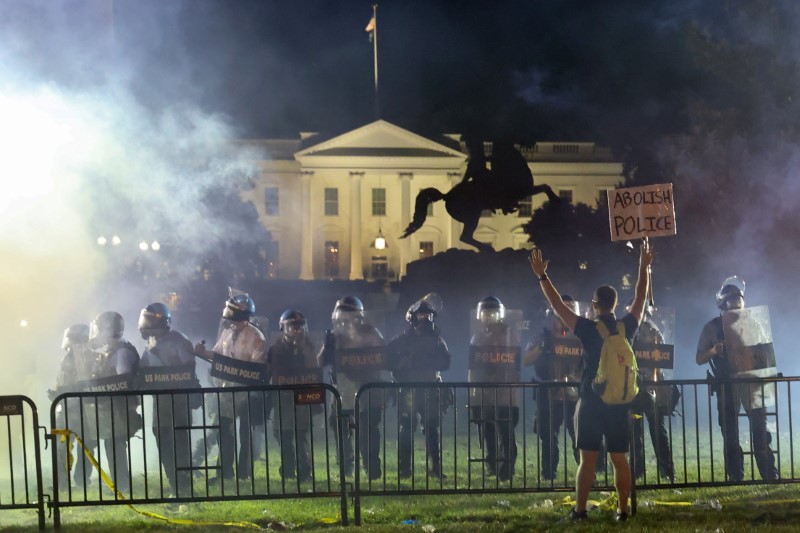
By Nathan Layne and Brendan O’Brien
NEW YORK/MINNEAPOLIS (Reuters) – President Donald Trump on Tuesday said U.S. troops should take to the streets of New York City to quell unrest, as authorities across the country prepared for another night of protests over the death of an unarmed black man in police custody.
Dozens of cities are under curfews. The head of the U.S. National Guard said on Tuesday that 18,000 Guard members were assisting local law enforcement in 29 states.
Lawmakers and law enforcement officials seemed taken aback by the extent of mayhem overnight in some major U.S. cities where police were shot at and pelted with rocks and projectiles as they faced hostile crowds.
Demonstrators smashed windows and looted stores in New York, including luxury retailers on Fifth Avenue, and set fire to a Los Angeles strip mall. Four officers were shot in St. Louis and one in Las Vegas who was critically wounded, authorities said.
Trump has threatened to use the military to battle violence that has erupted nightly, often after a day of peaceful protests. He has derided local authorities, including state governors, for their response to the disturbances.
“NYC, CALL UP THE NATIONAL GUARD. The lowlifes and losers are ripping you apart. Act fast!” Trump tweeted on Tuesday. He deploying thousands of armed soldiers and law enforcement in the U.S. capital and vowed to do the same wherever authorities fail to regain control.
New York Governor Andrew Cuomo voiced outrage at the chaos in America’s largest city, saying its mayor and police force “did not do their job last night.” He said he believed Mayor Bill de Blasio underestimated the scope of the problem.
The governor said he had offered the state’s mayors support from state police or 13,000 National Guard who are on standby and said that with a 38,000-strong police force, New York City should be able to address its unrest on its own.
He added that Trump sought to blur the line between protesters representing a cross-section of Americans with a legitimate cause and looters. Authorities blame the looting and vandalism on a relatively small number of people protesting against police brutality.
De Blasio poured cold water on the idea of deploying the National Guard in his city.
Demonstrators have taken to the streets over the death of George Floyd, a 46-year-old African American who died after a white policeman pinned his neck under a knee for nearly nine minutes in Minneapolis on May 25.
Derek Chauvin, the 44-year-old Minneapolis police officer who planted his knee on Floyd’s neck, has been charged with third-degree murder and second-degree manslaughter. Three other officers involved have not been charged.
MARTIN LUTHER KING REMEMBERED
Floyd’s death has reignited the explosive issue of police brutality against African Americans and led to a painful reexamination of race relations five months before a divided America votes in a presidential election.
Some of those who have gathered at the site of Floyd’s killing have invoked the non-violent message of the late U.S. civil rights leader Martin Luther King Jr., assassinated in 1968, as the only way forward.
“He would be truly appalled by the violence because he gave his life for this stuff,” said Al Clark, 62, a black man who drove to the Minneapolis memorial with one of King’s speeches blaring from his truck.
“But I can understand the frustration and anger.”
In Atlanta, six officers will face charges for an incident in which two college students were removed from their car and tased, Fulton County District Attorney Paul Howard told a briefing. Two of the six officers were terminated on Sunday.
A police officer in Sarasota, Florida, was placed on leave on Tuesday after video surfaced showing the officer kneeling on a man’s back and neck during an arrest in May.
Officers were injured in clashes elsewhere, including one who was in critical condition after being hit by a car in the Bronx, police said.
The protests have escalated racial tensions in a country hit hard by the coronavirus pandemic, with African Americans making up a disproportionately high number of cases and being hard hit by job losses from lockdowns to stop the spread of the virus.
Critics accuse Trump, who is seeking re-election in a Nov. 3 election, of further stoking conflict and racial tension rather than seeking to bring the country together and address the underlying issues.
“President Trump is right to be focused on law and order. He wasn’t hired to be the consoler-in-chief,” said Jason Miller, who advised the Republican Trump’s 2016 presidential campaign.
Democratic presidential candidate Joe Biden pledged in a speech on Tuesday to try to heal the racial divide in America and blasted Trump’s response to the protests.
(Reporting by Barbara Goldberg, Lisa Lambert, Maria Caspani, Peter Szekely, Zachary Fagenson, Brendan O’Brien, Nathan Layne, Susan Heavey and Brad Brooks; Writing by Paul Simao; Editing by Howard Goller)



















